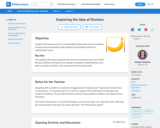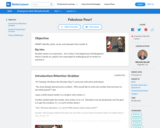
Learning about exponents helps students think about and understand expressions.
- Subject:
- Mathematics
- Material Type:
- Lesson Plan
- Provider:
- BetterLesson
- Date Added:
- 12/01/2022

Learning about exponents helps students think about and understand expressions.

Students will explore what they can do with balls, cars, marbles, and ramps and document findings in their science journals. This will engage their curiosity, allow them to make self-discoveries, and explore self-interests.

Students will use weather data they collect to predict future weather. Included in this lesson are a weather forecasting recording sheet and an example of a student's completed work.

Students will use area models and expressions to help build a solid foundation of how the distributive property works.

Students will observe and try to model slightly above-level division problems as they practice expressing math questions and possible solutions in mathematical terms.

Something seems familiar here: Students learn how allusion invites more into a text. Using "The House On Mango Street" students will learn about allusion by paralleling events from both the Bible and from Greek mythology.

Use real world examples to evaluate and solve expressions.

Students use their partners of 10 to add numbers to 1,000 in partners of 100.

Students continue to work on understanding and comparing ratios.

Students identify, write, count, and represent the number 4.

How does air affect our weather? Students will conduct an experiment to demonstrate how air pressure and humidity work. Included are pictures and videos of the lesson in action, whole group and individualized instruction plans, and a wrap-up idea.

Students color seasonal images and sort them 3 different ways.

Students will determine if objects fall at the same speed by testing a variety of objects as they let them fall from above. They will learn that gravity is the force that is pulling on the object. Included in this lesson is a video about gravity on the moon, a printable recording sheet, and videos of the lesson in action.

Students continue to build their graphing skills. They experience a real world application of graphing by organizing survey results.

Students will tell if a shape is 2-dimensional or 3-dimensional.

Students use both area and perimeter to work with geometric shapes.

Variety is the spice of life and the concept of the day as students fill the same pattern block outline three different ways.

Students use knowledge about fractions and decimals to show what they know on their assessment.

Students show what they know about equations and inequalities.

Students define rate and give examples of how they can use rates.